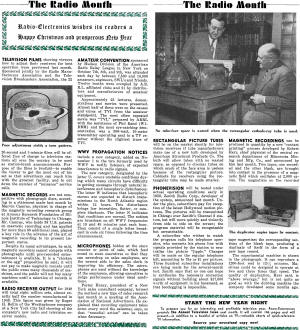|
December 1949 Radio-Electronics
 [Table of Contents] [Table of Contents]
Wax nostalgic about and learn from the history of early electronics.
See articles from Radio-Electronics,
published 1930-1988. All copyrights hereby acknowledged.
|
"The Radio Month" was
a regular feature in Radio-Electronics magazine in the late 1940s and early
1950s. It contained news items from around the industry and across the world. The
entire two pages are included in the included scan, but a couple items in particular
stand out that are worth mentioning. The first is announcing the soon to be available
rectangular cathode ray tubes (CRT) for television. Until then, the actual CRTs
had round faces even though the displayed image was rectangular. A 4:3 aspect ratio
was the standard, which required the tube diameter to be roughly 25% larger than
the horizontal size of the picture. In fact, that is how TV display sizes came to
be rated by their "diagonal" dimension rather than the picture width, and the standard
stuck even after rectangular tubes were available. For instance, the 4:3 aspect
ratio conveniently produces a diagonal length of 5 (the 3:4:5 triangle), where the
hypotenuse is c = sqrt(a2 + b2) = sqrt (42 + 32)
= sqrt (16 + 9) = sqrt (25) = 5. So, a 19" television would have a horizontal width
of 19 * sin (tan-14/3) = 15.2" and a vertical height of 19 * cos (tan-14/3)
= 11.4" . The other item was an announcement for the coming of Phonevision,
which never really did materialize as stand-alone appliances until smartphones
came online.
Radio Month
 Rectangular Picture Tubes will
be on the market shortly for television receivers if tube manufacturers make use
of a new bulb developed by American Structural Products Co. The bulb will allow
tubes with no wasted space, as opposed to circular tubes on which much of the face
area is useless because of the rectangular picture. Cabinets for receivers using
the rectangular tube may be made smaller. Rectangular Picture Tubes will
be on the market shortly for television receivers if tube manufacturers make use
of a new bulb developed by American Structural Products Co. The bulb will allow
tubes with no wasted space, as opposed to circular tubes on which much of the face
area is useless because of the rectangular picture. Cabinets for receivers using
the rectangular tube may be made smaller.
Phonevision will be tested under actual operating conditions
early in 1950, Zenith Radio Corp., developer of the system, announced last month.
Under the plan, subscribers pay for reception of the latest Hollywood motion pictures.
The pictures will be transmitted in Chicago over Zenith's Channel 2 station, but
will move quickly and violently from side to side on the screen; the program material
will be recognizable but unwatchable. A subscriber who wishes to watch the program
calls his telephone operator, who connects his phone line with signals provided
by the station to neutralize the picture "jiggle." Charges will be made on the regular
telephone bill, amounting to 75¢ or $1 per picture. Three hundred subscriber
installations are being made for the several-month test. Zenith says that no one
can hope to synthesize the necessary correction signals without building about $17,000
worth of equipment in his basement, so that bootlegging is impossible.
Posted October 15, 2020
|









